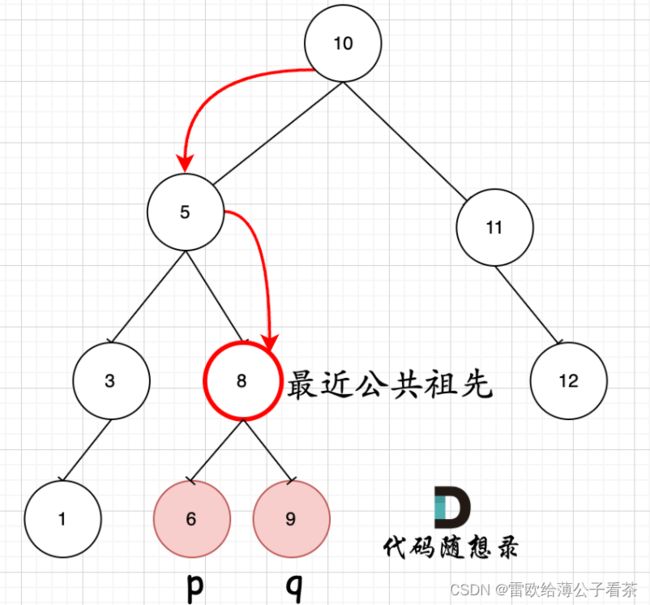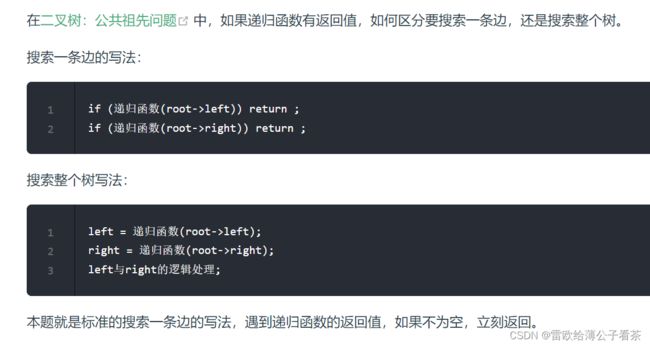代码随想录算法训练营第22天|235. 二叉搜索树的最近公共祖先 ● 701.二叉搜索树中的插入操作 ● 450.删除二叉搜索树中的节点
- ● 一个模板
-
- 1.思路
- 2.代码实现
- ● 235. 二叉搜索树的最近公共祖先
-
- 1.思路
- 2.代码实现
- ● 701.二叉搜索树中的插入操作
-
- 1.思路
- 2.代码实现
- ● 450.删除二叉搜索树中的节点
-
- 1.思路
- 2.代码实现
● 一个模板
文字
视频
题目
1.思路
2.代码实现
● 235. 二叉搜索树的最近公共祖先
文字
视频
题目
1.思路
方法一:递归
在有序树里,如果判断一个节点的左子树里有p,右子树里有q呢?
因为是有序树,所有 如果 中间节点是 q 和 p 的公共祖先,那么 中节点的数组 一定是在 [p, q]区间的。即 中节点 > p && 中节点 < q 或者 中节点 > q && 中节点 < p。
那么只要从上到下去遍历,遇到 cur节点是数值在[p, q]区间中则一定可以说明该节点cur就是q 和 p的公共祖先。 那问题来了,一定是最近公共祖先吗?
当我们从上向下去递归遍历,第一次遇到 cur节点是数值在[p, q]区间中,那么cur就是 p和q的最近公共祖先。
本题就不涉及到 前中后序了(这里没有中节点的处理逻辑,遍历顺序无所谓了)。

可以看出直接按照指定的方向,就可以找到节点8,为最近公共祖先,而且不需要遍历整棵树找到结果直接返回

方法二:迭代
利用其有序性,迭代的方式还是比较简单的
2.代码实现
递归
class Solution {
public TreeNode lowestCommonAncestor(TreeNode root, TreeNode p, TreeNode q) {
if(root==null)
return null;
if(root.val>p.val && root.val>q.val ){
TreeNode left=lowestCommonAncestor(root.left, p, q);
if(left!=null)
return left;
}
else if(root.val<p.val && root.val<q.val ){
TreeNode right=lowestCommonAncestor(root.right, p, q);
if(right!=null)
return right;
}
return root;
}
}
迭代
class Solution {
public TreeNode lowestCommonAncestor(TreeNode root, TreeNode p, TreeNode q) {
while(root!=null){
if(root.val>p.val && root.val>q.val)
root=root.left;
else if(root.val<p.val && root.val<q.val)
root=root.right;
else
return root;
}
return null;
}
}
● 701.二叉搜索树中的插入操作
文字
视频
题目
1.思路
方法一:递归
递归函数可以有返回值,也可以无返回值
有返回值的话,可以利用返回值完成新加入的节点与其父节点的赋值操作。即下一层将加入节点返回,本层用root->left或者root->right将其接住。
没有返回值,需要记录上一个节点(parent),遇到空节点了,就让parent左孩子或者右孩子指向新插入的节点。然后结束递归。
网上千篇一律的代码,可能会误导大家认为通过递归函数返回节点 这样的写法是天经地义,其实这里是有优化的!
方法二:迭代
在迭代法遍历的过程中,需要记录一下当前遍历的节点的父节点,这样才能做插入节点的操作。
2.代码实现
递归:
class Solution {
public TreeNode insertIntoBST(TreeNode root, int val) {
if(root==null){
TreeNode temp=new TreeNode(val);
return temp;
}
if(root.val>val)
root.left=insertIntoBST(root.left,val);
else if(root.val <val)
root.right=insertIntoBST(root.right,val);
return root;
}
}
迭代
class Solution {
public TreeNode insertIntoBST(TreeNode root, int val) {
if(root==null){
TreeNode temp= new TreeNode(val);
return temp;
}
TreeNode parent=root;
TreeNode cur=root;
while(cur!=null){
parent=cur;
if(cur.val>val)
cur=cur.left;
else if(cur.val<val)
cur=cur.right;
}
TreeNode temp=new TreeNode(val);
if(parent.val>val)
parent.left=temp;
else
parent.right=temp;
return root;
}
}
● 450.删除二叉搜索树中的节点
文字
视频
题目
1.思路
这里就把二叉搜索树中删除节点遇到的情况都搞清楚。
有以下五种情况:
第一种情况:没找到删除的节点,遍历到空节点直接返回了
找到删除的节点
第二种情况:左右孩子都为空(叶子节点),直接删除节点, 返回NULL为根节点
第三种情况:删除节点的左孩子为空,右孩子不为空,删除节点,右孩子补位,返回右孩子为根节点
第四种情况:删除节点的右孩子为空,左孩子不为空,删除节点,左孩子补位,返回左孩子为根节点
第五种情况:左右孩子节点都不为空,则将删除节点的左子树头结点(左孩子)放到删除节点的右子树的最左面节点的左孩子上,返回删除节点右孩子为新的根节点。
2.代码实现
class Solution {
public TreeNode deleteNode(TreeNode root, int key) {
if(root==null)
return null;
else if(root.val==key){
//叶子节点
if(root.left==null && root.right==null)
return null;
//左孩子为空右孩子不为空,右孩子继位
else if(root.left==null && root.right!=null)
return root.right;
//右孩子为空左孩子不为空,左孩子继位
else if(root.right==null && root.left!=null)
return root.left;
//左右孩子均不为空,右孩子继位
else{
TreeNode cur=root.right;
while(cur.left!=null){
cur=cur.left;
}
cur.left=root.left;
return root.right;
}
}
if(root.val>key)
root.left=deleteNode(root.left,key);
else if(root.val<key)
root.right=deleteNode(root.right,key);
return root;
}
}